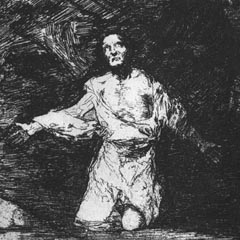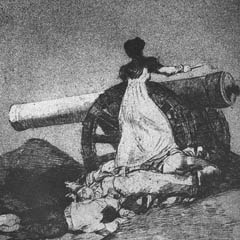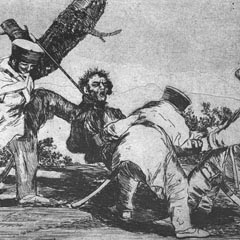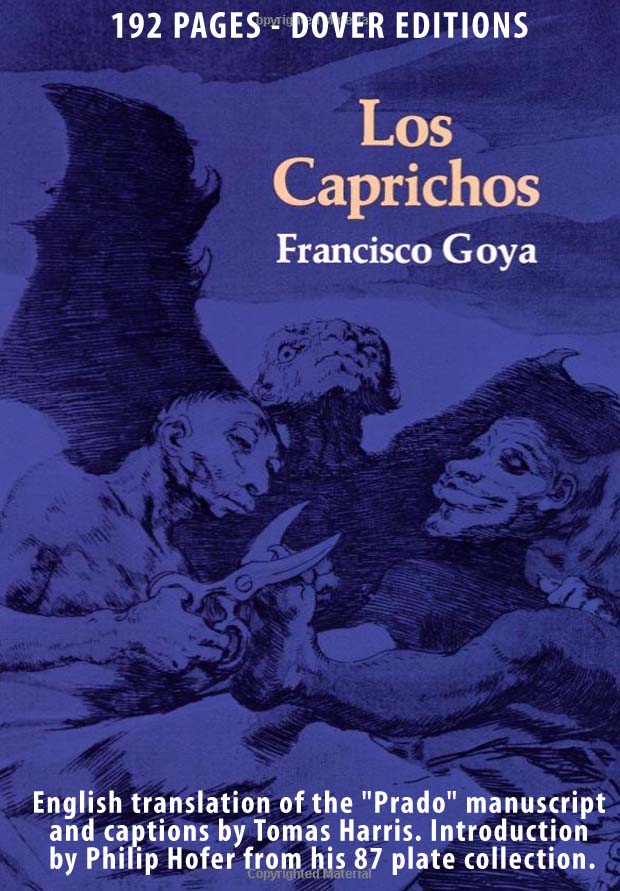Goya | Disasters of War
Fatales consequecias de la sangrienta guerra en España con Buonaparte. Y ostros caprichos enfáticos
aka Fatal Consequences of the Bloody War in Spain against Bonaparte and other Emphatic Caprichos*
The Spanish civilians bore the brunt of the worst excesses of the war between France and Spain. Atrocities committed by the occupying French troops** were meant to quell resistance, but instead were followed by worse atrocities from Spanish rebels. This cycle broke down even what limited rules policed war in the 1800s, and the anarchy of destruction turned Spain into a land devoid of restraints. This cruelty impacted Goya in such a way that his response - the series of plates which make up The Disasters of War - seem both an indictment and a question, about Spain, the French, and humankind.
Goya worked on the series over a period of six years, and there are questions as to how many plates actually belong in the intended set. Usually 83 plates are accepted as belonging to the project, though the last three were added after the original set were published in 1863 by the Royal Academy of Fine Arts of San Fernando, decades after Goya's death. Those three "additional" plates were found only after that first public edition.
Though not published in his own lifetime, Goya made his own test proofs, and Philip Hover (in his introduction to the 1967 Dover edition of the Royal Academy set) and many scholars describe the set as being 64 plates of reportage, but 16 plates are "enigmatic" and are more in the nature of visions. Plates 2 through 47 are war correspondence based upon news, eyewitness stories, and even Goya's own experience, such as plate 44, titled Yo lo vi ("I saw it"). Plates 48 to 65 continue with reporting of the effects of the conflict on and around Madrid, featuring starvation and the plight of survivors, often huddled into groups amid a barren scene of destruction, alive but still in a dire predicament.
The remaining plates depict Goya using allegory and satire, sometimes depicting the resumption of the power of the Spanish aristocracy and Spanish monarch Fernando VII following the end of Napoleon's control of Spain (that control was via crowning his brother Joseph as a rather temporary king) and in Goya's pictures, they are presented as an extension of the disaster, not a solution (see, for example, plate 79: "truth has died").
The entire set is initiated by plate 1 (usually put into English as "sad presentiments of what's about to happen") with a haggard man in torn clothing upon his knees, arms outstretched, looking into the gathering gloom, perhaps beseeching God, or in turmoil over what they both know is about to happen.
"His debt to Christianity of the eighteenth century is contained in the idea that politics was just adopting from the Gospels; the conviction that man has a right to justice. Such a statement would seem utterly conceited to a Roman, who would doubtless have looked upon the Disasters as we look on photographs of the amphitheatre... But if Goya thought that man has not come onto the earth to be cut in pieces, he thought that he must have come here for something."
Page 112, from Andre Malraux's Saturn : An essay on Goya Phaidon Press 1957
"Here in Goya is the beginning of our modern anarchy." - quote attributed to art critic Bernard Berenson in 1932.
Page I, Introduction to the Dover Edition The Disasters of War , Philip Hofer, Dover Publications 1967
"The prints Goya produced at this time... form perhaps the most uncompromising artistic record of conflict ever produced. The artist's inspiration came from the analysis of rural guerrilla combat, even squalid and grotesque episodes of rape, murder, the mutilation of corpses, the abandonment of children and the atrocities committed by French troops and their Spanish opponents."
Page 239-240, from Sarah Symmon's Goya
(Art and Ideas series), Phaidon, 1998
Books containing the entire etching set:
The Disasters of War: 85 Etchings, Reproduced in Actual Size 9.1 x 6.6 x 1.1 inches
The Disasters of War (Dover Fine Art) 8 x 0.2 x 9 inches
The disasters of war;: 85 aquatint etchings by Francisco de Goya (Doubleday anchor books) 7 x 4.3 x 0.3 inches
The Complete Etchings of Goya, Crown Publishers. 12.2 x 9.2 x 1.3 inches
*The title Goya gave a proof set which he gifted to a friend.
** See a special note regarding the French and Spanish actions on the page regarding plate 69 "nada"
The Disasters of War
Plate 1
Fristes presentimientos - Gloomy Presentiments
Plate 7
What Courage! - Que Valor! - Augustina Zaragoza
Plate 39
Great deeds against the dead
Grande hazaña! Con muertos!
Plate 69
Nada. Ello Dira - Nothing
AMAZON
Goya The Terrible Sublime - Graphic Novel - (Spanish Edition) - Amazon
"From this headlong seizure of life we should not expect a calm and refined art, nor a reflective one. Yet Goya was more than a Nietzschean egoist riding roughshod over the world to assert his supermanhood. He was receptive to all shades of feeling, and it was his extreme sensitivity as well as his muscular temerity that actuated his assaults on the outrageous society of Spain." From Thomas Craven's essay on Goya from MEN OF ART (1931).
"...Loneliness has its limits, for Goya was not a prophet but a painter. If he had not been a painter his attitude to life would have found expression only in preaching or suicide." From Andre Malroux's essay in SATURN: AN ESSAY ON GOYA (1957).
"Goya is always a great artist, often a frightening one...light and shade play upon atrocious horrors." From Charles Baudelaire's essay on Goya from CURIOSITES ESTRANGERS (1842).
"[An] extraordinary mingling of hatred and compassion, despair and sardonic humour, realism and fantasy." From the foreword by Aldous Huxley to THE COMPLETE ETCHINGS OF GOYA (1962).
"His analysis in paint, chalk and ink of mass disaster and human frailty pointed to someone obsessed with the chaos of existence..." From the book on Goya by Sarah Symmons (1998).
"I cannot forgive you for admiring Goya...I find nothing in the least pleasing about his paintings or his etchings..." From a letter to (spanish) Duchess Colonna from the French writer Prosper Merimee (1869).
GOYA : Los Caprichos - Dover Edition - Amazon









